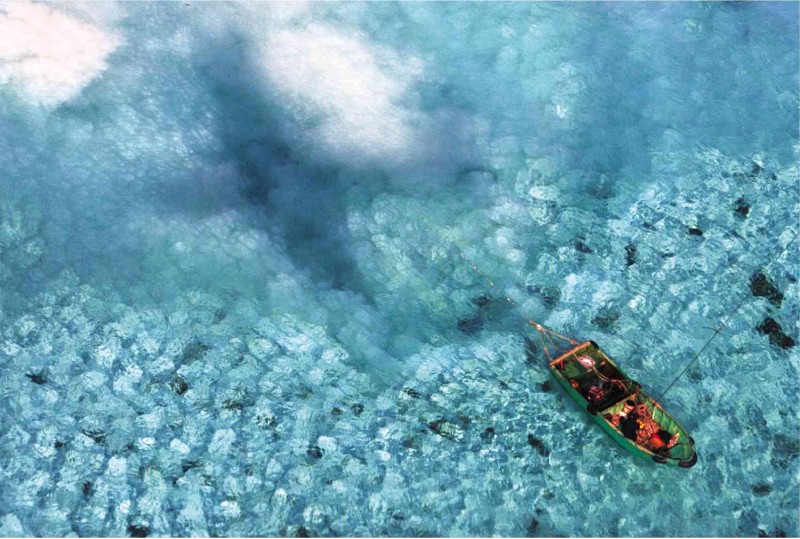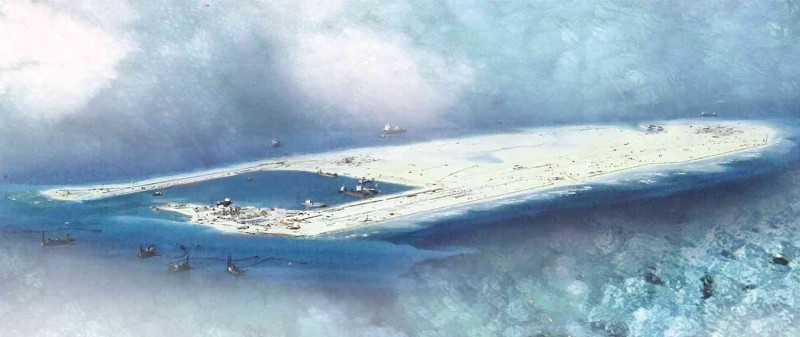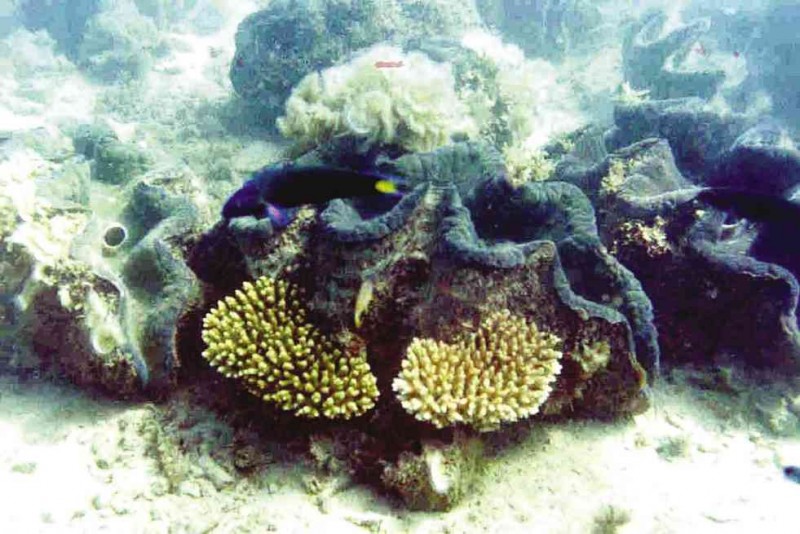Destroyed reefs, vanishing giant clams
While the news in recent weeks have dwelt on the rapid “reclamation” by China of more than half a dozen submerged coral reefs and atolls in the West Philippine Sea, no one seems to be paying attention to the unprecedented environmental havoc directly caused by man on the most productive and economically valuable natural ecosystems on the planet.
Attention has been focused on the potential military and political gains of China, but no one is watching what the Philippines and all the other countries that have some dependence on the wider South China Sea are losing economically, including China itself.
The purpose of this article is to highlight the natural resource losses brought about by China’s reclamation activities within our exclusive economic zone (EEZ) and beyond.
Burying ecosystems
While satellite images over the past half year or so have dramatically shown the emergence of sand islands in seven features of the ocean stretching from the Fiery Cross Reef beyond our EEZ to our Panganiban Reef (aka Mischief Reef), only about as far from Palawan as Pangasinan is to Manila, the images can barely make out the highly productive marine ecosystems that are being buried in the process—the coral reefs and sea-grass beds that support a highly productive fisheries production, among many benefits.
Today, several satellite sources are open to the public, whether freely made available or purchased from commercial companies, including Jane’s Satellite Imagery Analysis. With assistance from the secretariat of the National Security Council, the writer was able to obtain last March, a tabulation of the areas that had been reclaimed. (See Table 1.)

• A Chinese boat scrapes the coral reef bed in Panatag (Scarborough) Shoal off Zambales province. NIÑO JESUS ORBETA
More than 311 hectares
As of the end of March, at least 311 hectares of filled in reef areas were manifest. Remember that a hectare is 10,000 square meters. That is not a trivial area of coral reef ecosystems smothered or wiped out from the face of the Earth. Other areas, notably our Panganiban Reef, are not yet included. Nor is the ocean filling complete. It need not be emphasized that these biogenic geological structures take millennia to eons to construct under normal conditions of climate. What more under climate change regimes.
But it is really of no interest to argue how long a time horizon will be needed to rebuild lost reefs. What is of interest here is what we have lost in terms of ecological services, including living marine resources. “We” in this context includes not only the Philippines but all the nations around the South China Sea and beyond, including China.
Value to mankind
While many people only value the fish or fisheries that produce food for the table, marine ecosystems provide much more in terms of services to mankind than the fish we eat. The consideration of natural resource accounting dates some decades, with a paper published in the prestigious scientific journal Nature on May 15, 1997.
In a landmark article, Robert Costanza and coauthors posited that nature provides mankind as much if not more benefits than industry, the problem being that not all are tradable. What is a beautiful scenery worth to man? A sunset? The authors went on to give monetary values to the myriad ecosystem services and good provided by natural ecosystems and came up with a surprising figure.
One of his coauthors continued to work on the valuation of ecosystems. In 2014, (Rudolf) de Groote copublished a much-cited paper which builds on and updates with newer cases the study of Costanza. In this more recent paper, De Groot and coauthors came up with a table for the ecological services provided by coral reef ecosystems. (See Table 2.)
The bottom line is that coral reef ecosystems provide man and nature with a monetary value of $352,000 per hectare per year.
Losing $100M a year
What have the Philippines and neighboring countries lost on account of the reclamation of the Chinese? As of the end of March, the approximate amount was a whopping $100 million per year, so far, in terms of ecosystem services to us and our neighbors, indeed, for all of humanity. And what are the Chinese offering in return?
From a more practical standpoint, the destruction of these support ecosystems will adversely affect the fisheries of all the nations fishing in the South China Sea. This large marine system’s importance cannot be overemphasized. It is a major fishing region of the world and for the Philippines. Time was when as much as 25 percent of our marine fisheries production came from this region. This has now been compromised and may continue to decline if Chinese destructive and aggressive activities continue.
Coral Triangle
It may be recalled that some six years ago, on the recommendation of the former President of Indonesia, Susilo Bambang Yudhoyono, the Coral Triangle Initiative (CTI) was launched in Manado, Sulawesi (Indonesia), in May 2009 because Asia Pacific Economic Cooperation members had agreed that the “Center of Marine Biodiversity” of the world needed special attention and conservation.
This initiative is focused on coral reefs as the base ecosystem, supporting the livelihood of hundreds of millions of people, and providing food and many other ecosystem services.
The defining characteristic for inclusion in the CTI was to have at least 500 species of hard corals, a condition then seen to be fulfilled only by six countries, namely, the Philippines, Indonesia, Malaysia, Papua New Guinea, Solomon Islands and Timor Leste.
More recent studies have revealed, however, that the South China Sea harbors some 500 coral species as well.
New coral species
Marine scientists from De La Salle University and the University of the Philippines Marine Science Institute discovered a new species of coral in the recent past in our Kalayaan Islands, leading them to name the coral Leptoseris kalayaanensis.
How many more undiscovered species in the Spratlys are there? And how many of those might be buried and lost to mankind by the reclamation activities of the Chinese even before they are discovered? This is one of the concerns of the Convention of Biological Diversity, to preserve the biodiversity of the planet because of the ecosystem services provided by the diversity of plants and animals. Are the decision-makers in Beijing cognizant of their responsibilities?
Bloomberg news recently quoted a Chinese foreign ministry spokesperson, Hua Chunying, as saying: “We put equal emphasis on construction and protection by following a high standard of environmental protection and taking into full consideration the protection of ecological environment and fishing resources….”
Further, she said, “It does not impact or target any country, and is thus beyond reproach.” Perhaps, she is making a distinction between targeting a single country versus targeting all the littoral states in this highly diverse large marine ecosystem.
Bingos silent
Where are the Bingos in this conservation issue? Conservationists and marine scientists in the know were aware that the “big NGOs or Bingos” (World Wide Fund, Conservation International and The Nature Conservancy being the principal ones in the region) were very active in pushing the CTI.
Of course, they are much involved in various activities of the CTI today. In the present crisis of the massive reclamation of the coral reefs, their silence is deafening. I was informed by a Filipino based in New York, concerned with the current issues, that at least two of the three Bingos mentioned previously had been approached to weigh in, but had decided to keep distance.
This is puzzling because the large organizations profess to conserve important ecosystems and yet, they do not seem to be in touch with the present situation in the South China Sea. Or they may be concerned about losing support from China for their other conservation initiatives, like preserving a cute black-and-white animal that eats bamboo leaves?
Scientific expeditions
Over the past several decades, several coastal countries have undertaken scientific expeditions in the region, whether individually or collectively. Among the earlier explorations were those of Malaysia, under the rubric of “Matahari” expeditions, although these only touched the southern rim of the South China Sea. Several “Joint Oceanographic and Marine Scientific Research Expeditions” were undertaken by the Philippines and Vietnam, initiated under the presidency of Fidel Ramos.
Initiated under the leadership of Ambassador Hasjim Djalal of Indonesia, the Track 2 series of workshops on managing potential conflicts in the South China Sea led to the joint expedition to the Anambas area of the southern part about a decade ago, involving participants from several countries, including Singapore with its expertise in marine biodiversity.
At the home front, sporadic expeditions to the Kalayaan Islands Group occupied by the Philippines have been undertaken. The Bureau of Fisheries of old led one or another of these scientific and fisheries explorations. Mention was earlier made about the discovery of a new species of coral, this having been done during the later studies led by the UP Marine Science Institute.
Recently, a marine scientific research expedition was about to depart for the area, but was canceled at the last minute by Malacañang for reasons that one can only speculate about. If we do not show the flag frequently enough in the areas of the West Philippine Sea that we occupy, might others interpret this as lack of interest?
Risks may be involved, but unless Filipinos show the determination that the Vietnamese demonstrated in the recent past that resulted in the Chinese pulling away their oil drilling platform from an area about as far from their mainland as the Panganiban Reef is from Palawan, what can we expect in the future?
Carved giant clam shells
Time was when large giant clams, referred to in old Vietnamese fishers accounts as shells as large as elephant’s ears, were common throughout the islands and reefs of the large marine ecosystem we have been concerned about.
Today, it will be a miracle if one can find a true giant clam in the Paracels, the Spratlys, or Panatag Shoal (Scarborough Shoal). They have all been harvested by hungry Hainanese fishers and other Chinese agents, not for their meat but for their shells. Even shells long dead and buried in sand have been dug out by Chinese fishers and taken by ship to Hainan, as reported in the Inquirer on March 7, 2014.
Mystery solved
The mystery of where shiploads of giant clam shells were going to and what they were used for was a puzzle for this marine biologist who has studied giant clams for decades and started their restocking in Philippine reefs, so that they can be found today in many diving destinations in the country.
By chance, while preparing for a trip to Hainan two years ago, an American tourist who had visited Boao, the site of the Asian Economic Forum, sent photos of giant clam shells carved for the tourist trade. Upon investigation, it was discovered that there are literally hundreds of tourist shops in Tanmen, Hainan which is very near Boao, selling nothing but carved giant clam shells, as well as mounted whole shells and a small number of coral skeletons!
Ivory substitute
It would appear that because ivory is now a controlled material that cannot be legitimately sourced continually, tridacnid clam shells are being used as a substitute substrate. The advertisements in the shops promote their sale to tourists by saying that the shells bring good luck as a Buddhist belief!
It should be borne in mind that the giant clam species are all listed under Appendix 2 of the Convention on the International Trade of Endangered Species of Wild Fauna and Flora, to which virtually all the countries around the South China Sea subscribe.
So, why is China promoting the wholesale extirpation of the largest bivalve mollusc in the world? Only the paradoxical Chinese minds can figure out the rationale, if any, for their contradictions between what they say and what they do.
Edgardo D. Gomez, Ph.D. is professor emeritus of the University of the Philippines Marine Science Institute. He was proclaimed a National Scientist in 2014.
For comprehensive coverage, in-depth analysis, visit our special page for West Philippine Sea updates. Stay informed with articles, videos, and expert opinions.























